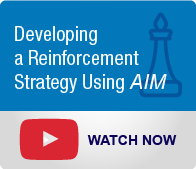One of the biggest frustrations Change Agents and Project Teams confront is lack of adoption of the change by the Targets. There is no doubt that the “status quo” is a powerful force, even when a change is positive or entirely rational. Very often, the reason why the change isn’t embraced is because the appropriate reinforcements are  not in place. For some reason, we expect people to behave differently, but we reinforce them for staying the same!
not in place. For some reason, we expect people to behave differently, but we reinforce them for staying the same!
This is a major issue for all types of changes, but with so many organizations attempting costly large scale, complex change, the reinforcement problem can’t be overlooked. Take a look at your own project, and see if you might have unknowingly missed fixing one of these 8 barriers to reinforcement--and therefore, impacted the likelihood and speed of change adoption.
8 Potential Barriers to Change Adoption
Barrier 1: Rewards reinforce the present state, not the desired state
If you want people to do something different, you need to have the appropriate incentives in place to motivate them to change. As Don Harrison, IMA President, would say, “Simple, no?”
Barrier 2: There is an over-reliance on formal performance management systems (performance appraisals, annual bonus, etc.)
The problem with the formal systems is that they are too slow. If you are trying to get adoption now, and the reinforcement doesn’t kick in for another 6 months, it isn’t motivating. The most powerful reinforcement for adoption must be applied immediately following the behavior.
Barrier 3: Formal performance management systems, legal contracts and agreements prohibit flexibility
Managers need to be able to apply the incentives and consequences that will drive the desired behaviors. If there is no flexibility, it becomes very difficult to adjust to individual needs.
Barrier 4: Rewards are not seen as meaningful for the Targets
Change Agents and Sponsors can easily make incorrect assumptions about what incentives are meaningful for people. Not everyone wants to be promoted, or be given a lot of public recognition. Others thrive on it. That’s why we say that we must know the “Frame of Reference” of the Targets.
Barrier 5: Assuming managers possess insufficient skills to apply reinforcement on a formal and informal basis
Managers are far more insightful about reinforcements that will be meaningful than Change Agents who often don’t know the Targets at all. Also, the job of the manager is to reinforce direct reports to get the needed things done. So typically the skills are there, but the knowledge of what options are available may not be (see Barrier 6).
Barrier 6: Managers do not fully understand reinforcement options that currently exist within the organization
Change Agents can make a big contribution to driving reinforcements by offering a “menu” of potential reinforcements that extend beyond what managers typically consider-- the formal systems that are available. For example, an assignment to an important project might be a reward for some. Or it could be an afternoon off to attend a family event. The AIM Targeted Reinforcement Index tool provides a wide range of useful ideas.
Barrier 7: Over-reliance on consequences versus rewards inhibits speed
In some top down, compliance cultures, the “go-to” management approach may be to apply negative consequences, rather than positive rewards. We know that people will be much more motivated by the incentives rather than the punishments. That said, a balance is needed--it is also a mistake to have no negative consequences. Without negative consequences, the “kidney stone theory of change” is in full play; “This too shall pass….”
Barrier 8: Expecting processes to move laterally, when reinforcement remains vertical and hierarchical
This can be a big issue in enterprise-wide changes where the desired state requires behaviors like collaboration. Or implementing standardized processes that are a critical component of ERP implementations. The reinforcement has to model what you are seeking in the desired state!
There’s a very good reason why Building a Reinforcement Strategy is one of the core elements of the AIM Change Management Methodology. If you are trying to figure out how to drive change adoption, be sure you pay attention to your reinforcements.


